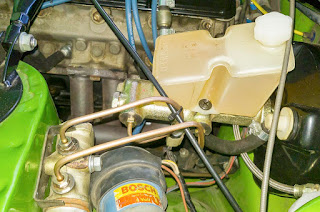Or the list gets shorter!
Clearly the car’s exterior needs a good clean as it has become rather dusty.
But that will be the last job! With all of the important jobs done (hopefully),
the plan was to drive the car as much as possible. Alas! So far that hasn’t
been going to plan. I only found time for a fairly short trip over a week ago.
But the weather wasn’t to photogenic, so no proof of that. But one of the first things I noted was that the
fuel gauge’s behaviour hadn’t changed. Which almost certainly means it is a problem with the fuel tank’s sender unit. So
that’ll have to wait till another time …
The subsequent
weekend’s weather wasn’t what you’d call nice to take a DHC out to enjoy! So
last Wednesday I decided to use the car for a work related trip to the northern
part of our Province. That didn’t go to plan, but luckily that had nothing to
do with the car. But at least because it got pretty late, I was able to drive
the car under night time conditions. This enabled me to find two small faults.
First one being that only three of the four LED’s for the dashboard
illumination are working. But as they are much brighter than the original bubs
I have decided to leave that for the time being.
The second problem I found
while driving home was that I was followed by a bright red glow. Turned out
that the brake lights were burning constantly. This must have been caused while
struggling underneath the dashboard when trying to get two bulbs from the
instrument cluster working. At least this one was easily sorted by bending the
brake switch’s bracket back to its original shape!
And while working in the driver’s
footwell I had a look at the throttle
pedal. Unhooking the throttle cable showed that the grease I put in there some
years ago still was doing its job. The pedal’s movement was light and smooth,
so no further action needed there. Only needed a tiny adjustment on the
throttle pedal’s stop to get WOT. Probably caused by a slight stretching of the
throttle cable over the years? Time for more checks underneath the bonnet:
First port of call was the throttle linkage
between the carburettors. Nothing wrong at that end of the throttle cable:
And as I was in that area of the engine bay I
gave the infamous hole underneath the water pump a quick inspection.
Everything’s fine there, with no signs of any leaks:
Another check had to do with the brakes. And
the fluid level to be more precise. This had dropped clearly, but not
alarmingly. I put it down to the brake pads bedding in. But I did check all
connections just to be sure (and for peace of mind). No leaks were found.
The final check was for the air filters. Those who
follow my ramblings on here will know that I moved the air filtering (in the
shape of two K&N cone filters) to the nose of the car. Here they have been
effectively cleaning air over the past few years. And although slightly dusty
they didn’t need any attention yet.
A more time consuming item on
the list were the seats. They were recovered in black leather somewhere in the
mid 90’s and fitted to ‘t Kreng but soon stored in the attic for future use as
they were not supportive enough for the car’s potential. After lingering in the
attic for many years they were fitted to the DHC in 2010. And since then I only
cleaned them once. So time for a thorough clean and a treatment with a leather
re-conditioner.
Not the nicest of jobs to perform, especially
as the seats are sitting pretty low when the car is on the drive! And the
outside temperature was on the wrong side of the scale for me! But after a few
hours of elbow grease the seats looked and felt much better. I also used the
opportunity to clean the rest of the interior!
And final job for now was the purchase and
fitting of the motorway vignettes for Switzerland and Austria. At least that
was easy!
So the list has become much
shorter:
- Check wear pattern on front brake pads and address some light squealing under light braking;
- Give the car a good polish and check tools, spare parts etcetera;
- Drive the car some more and final checks;
- Load the four stages of the route into the GPS and copy the route to a road atlas as back-up (just in case);
Buy and fit motorway vignettes for Switzerland and Austria;Fuel gauge, the old unit was registering almost empty constantly. See what the change of instrument cluster has had on this fault, I suspect the sender unit in the tank though;- Clean the leather seats and treat the leather with a conditioner;
- Check if the carburettors throttle’s open fully and lubricate linkage and throttle cable;











































